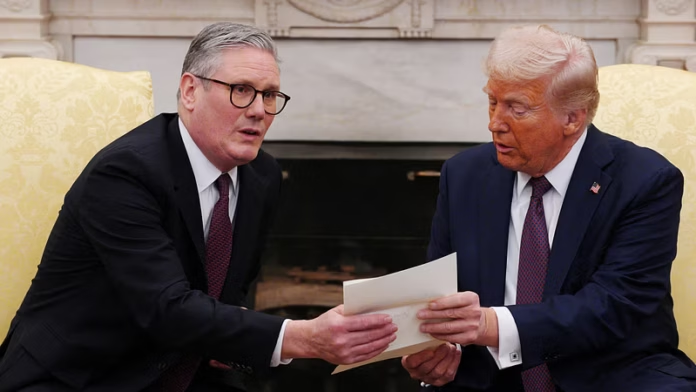In a major development for international trade, U.S. President Donald Trump and British Prime Minister Keir Starmer are likely to unveil a new U.S.-UK Trade Agreement 2025 on Thursday, which is designed to relieve tariff pressures and increase transatlantic trade.
The news is set to break at 10 a.m. EDT (1400 GMT) in a White House press conference where Trump called the deal a “major trade deal” in a Truth Social post. The agreement will be the first official pact since Trump launched sweeping global tariffs that have rocked supply chains and unsettled financial markets.
Emphasis on Steel, Autos, and Digital Tax
Sources close to the deal said the pact would most probably entail lower tariffs on British steel and autos, industries that were significantly hit by the U.S.’s 25% import tariffs. As a quid pro quo, the UK would reduce tariffs on American cars and offer concessions on its digital services tax, which had earlier hurt leading U.S. tech giants.
But the UK will continue to adhere to its rigorous food safety standards, rejecting U.S. calls for greater access for agriculture. The future of Trump’s baseline 10% tariff on almost all countries, including Britain, is uncertain.
Despite being narrow in scope, the deal is politically important for both nations. It offers Trump a diplomatic win amid growing global frustration with his aggressive trade strategy and gives Britain a chance to demonstrate progress post-Brexit while balancing its EU relations.
Also read: Trump’s Tariffs Impact on Chinese E-commerce and Adoption
A Strategic Shift in Trump’s Trade Policy?
The U.S.-UK Trade Agreement 2025 is viewed as a possible turning point in Trump’s trade strategy. His government initiated a tariff-bloated trade war early this year, which led to central banks and multinational companies threatening inflationary pressure and dampened growth.
The International Monetary Fund (IMF) has recently lowered global growth projections, blaming U.S. tariffs as one of the main causes. Economists worry that if tensions drag on, they will create supply chain disruption and a slowdown in world trade.
But recent moves imply a strategic reversal. Trump’s advisers have been holding regular consultations with key trade partners, and general tariff levels were put on hold for 90 days last month. Britain, in particular, was exempt from some of the tougher punishment since it takes in more goods from the U.S. than it sends abroad.
For Prime Minister Starmer, the agreement puts further speed into Britain’s wider trade objectives. Only days ago, the UK signed an independent agreement with India, reflecting its desire to move beyond the EU.
“This agreement re-establishes the United States as a vital partner to our economic and national security,” said a Downing Street spokesperson. “Negotiations have been going at a fast pace, and the Prime Minister will report back later today.
British authorities have stressed that they would like to safeguard important standards while leaving space for mutual economic gain with longstanding partners such as the U.S.
Markets Observing Closely
Financial markets and business executives are observing Thursday’s announcement. Although the agreement isn’t likely to reshape current trade arrangements, it could calm investor nerves and mark enhanced cooperation in trade.
For steel, auto, and tech companies, the agreement may mean reduced costs, fewer delays, and more transparent guidelines on digital taxation.
More generally, analysts see this deal, if successful, as potentially setting the tone for further bilateral agreements and even laying the groundwork for de-escalation in U.S.-China trade negotiations, which resume this weekend in Switzerland.
Also read: Trump Administration Blocks New $1B Federal Grants to Harvard
A Diplomatic Win with Global Ripples
As global trade tensions keep simmering, the U.S.-UK pact is a welcome exception. It provides Trump with a high-profile victory on the international stage and assists Britain in demonstrating its capability to seal significant deals outside of the EU.
While small in scale, the agreement could have disproportionate impact, and provide a dose of stability in an otherwise chaotic global trading environment.








